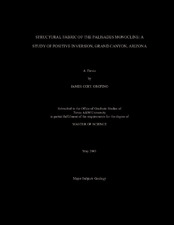| dc.description.abstract | A field study of positive inversion is conducted to describe associated structural
fabrics and to infer kinematic development of the Palisades Monocline, Grand Canyon,
Arizona. These features are then compared to sand, clay and solid rock models of
positive inversion to test model results and improve understanding of inversion
processes. The N40W 90 oriented Palisades fault underlying the monocline has
experienced northeast-southwest Precambrian extension and subsequent northeastsouthwest
Laramide contraction. The magnitude of inversion is estimated to be 25%
based on vertical offset across the fault, although this does not account for flexure or
horizontal shortening. The preferred N50W 90 joint and vein orientation and N50W 68
NE and SW conjugate normal faults are consistent with the Palisades fault and northeastsouthwest
extension. The N45E 90 joint orientation and approximately N40W 28 NE
and SW conjugate thrust faults are consistent with northeast-southwest contraction. The
deformation is characterized by three domains across the fault zone: 1) the hanging wall,
2) the footwall, and 3) an interior, fault-bounded zone between the hanging wall and
footwall. Extensional features are preserved and dominate the hanging wall,
contractional features define footwall deformation, and the interior, fault-bounded zone
is marked by the co-existence of extensional and contractional features. Extension
caused a master normal fault and hanging wall roll-over with distributed joints, veinsand normal faults. During inversion, contraction induced reverse reactivation of existing
hanging wall faults, footwall folding and footwall thrust-faulting. Precambrian normal
slip along the master normal fault and subsequent Laramide reverse slip along the new
footwall bounding fault created an uplifted domain of relatively oldest strata between the
hanging wall and footwall. Physical models of co-axial inversion suggest consistent
development of the three domains of deformation described at the Palisades fault,
however the models often require magnitudes of inversion greater than 50%. Although
vertical block motion during horizontal compression is not predicted directly by the
Mohr-Coulomb criterion, physical models and analytical solutions (incorporating Mohr-
Coulomb criterion) suggest maximum stress trajectories and near vertical failure above
high angle basement faults that compare favorably with the Palisades fault zone. | en |


